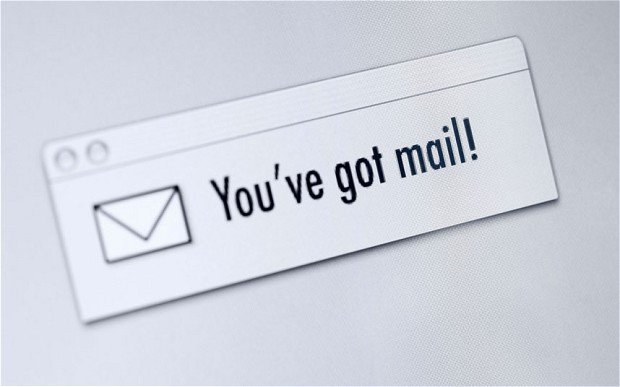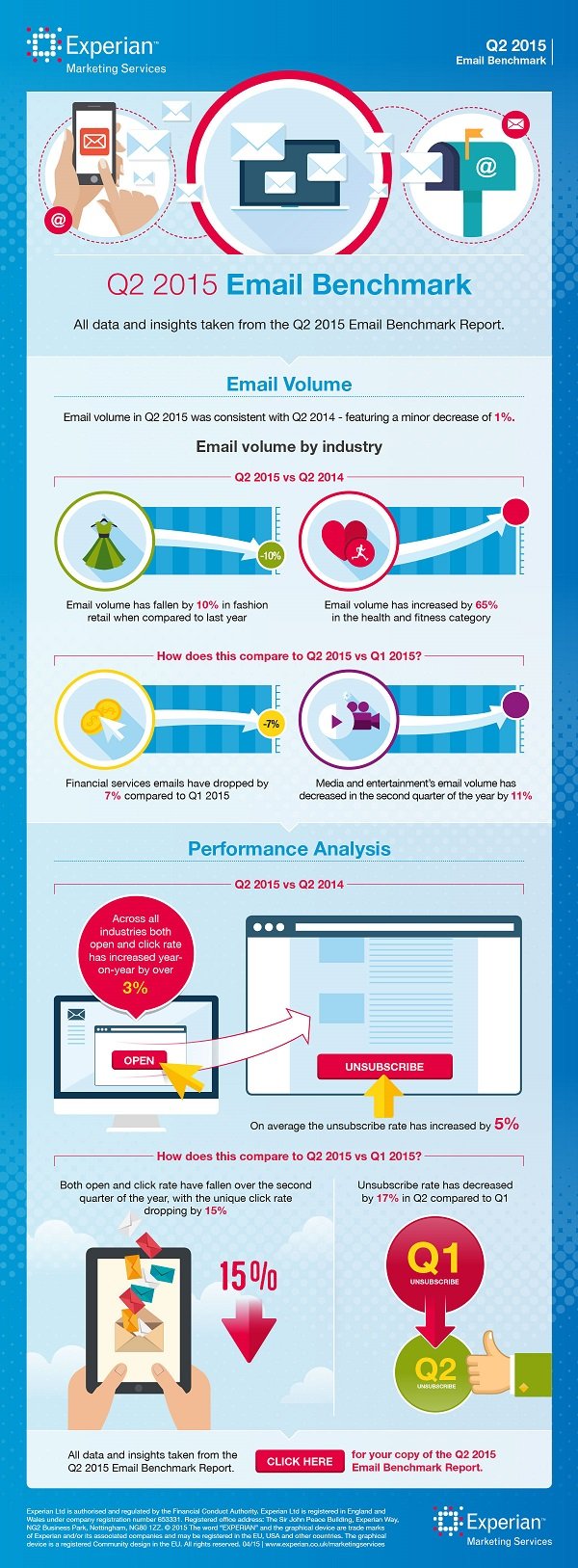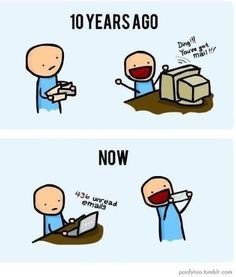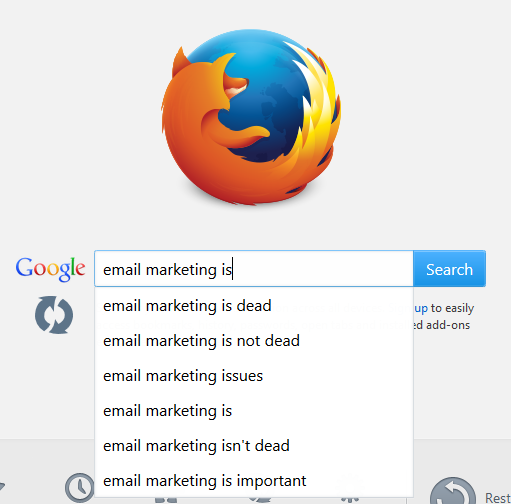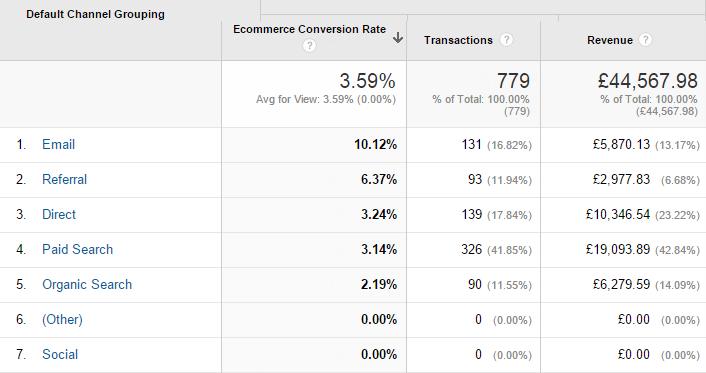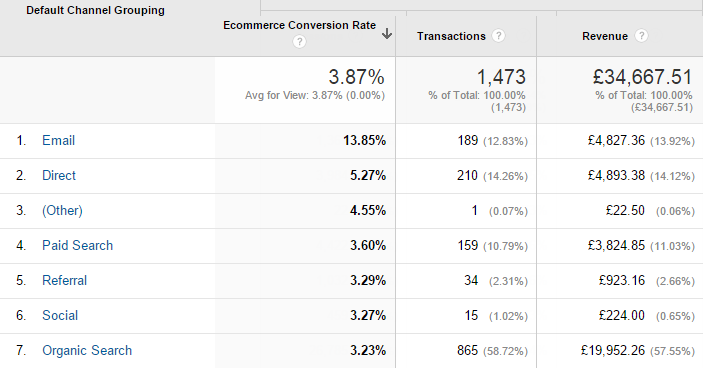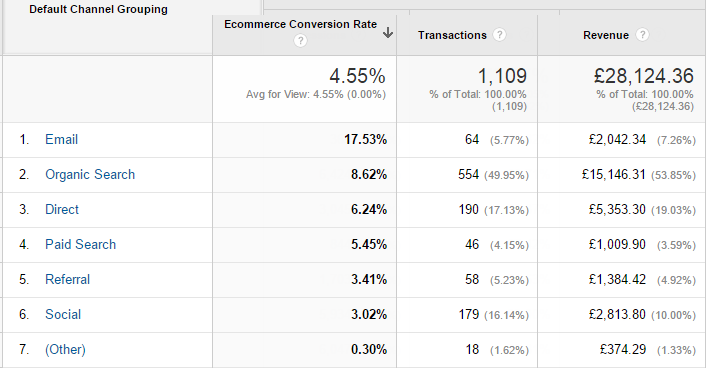Update: Some more, up to date facts about email marketing in the UK. Experian carry out quarterly email benchmarking and the quarter 2 2015 report was based on over 80,000 email campaigns (in excess of 7.5 billion emails) sent by Experian clients in the UK and Ireland. The analysis unearthed the following interesting email marketing facts:
- Campaigns using the words ‘choice’ or ‘choose’ in the subject line drive higher engagement and revenue rates than average
- These email creatives achieved 22% higher revenue per email, 46% increase in overall sales and a 117% increase in conversion rates
- 52% of total email opens in Q2 2015 were from a mobile phone or tablet
- 17% decrease in unsubscribe rate
- Email volume in Q2 2015 was pretty much at the same level with the previous year and previous quarter: the total number of emails sent across all industries decreased by 1% year-on-year and increased 4% quarter-on-quarter
Email marketing can be one of your most effective marketing channels. Really! Here are the facts and 3 real life examples of why…
- Fact #1: Email Marketing is misunderstood
- Fact #2: Email Marketing is underrated
- Fact #3: Email Marketing is underused
Email marketing has been a staple for consumer marketers since the mid-90s. Yet I continue to remain staggered by the number of small e-commerce businesses who either don’t invest in this channel or don’t do it very well.
One of the first questions we ask our clients during the onboarding process is what kind of email marketing campaigns they have been running. More often than not we are greeted with either a blank look of “You what?” or a dismissive wave of the hand coupled with a statement along the lines of “we tried that, waste of time”. In many cases, the response is simply that they just don’t believe email marketing to be a worthwhile channel to invest in compared to the bright lights & promised rewards that SEO can bring or the instant gratification that a PPC campaign brings in terms of online visibility.
Email, the naysayers will have you believe is a pedestrian way of communicating to the masses in this million mile per hour moving technological driven world of Facebook, Twitter, Instagram and about 50 other social media platforms I can no longer keep up with. I mean seriously, who under the age of 18 even knows what an email is today? Some people will even try to tell you that email marketing is dead.
Many online businesses dismiss email marketing because your average Joe’s inbox is stuffed with 2000 emails from various newsletters he has signed up with over the years. 9 times out of 10 this means deleting various promotional emails that you might have read but don’t have time because there are 1999 more waiting in the wings unread, never mind what new promotional fodder is going to come in next.
This graphic below sums it up quite nicely:
Even Google’s auto complete search function thinks Email Marketing is a waste of time from all the conversations it’s been snooping on around the world wide web. Type “Email marketing is” into Google and look at what suggestion it spits out first:
Yep – Email Marketing is dead.
However, I am here to tell you that actually, whilst some marketers claim it’s dead, I can say without hesitation that it is one of the most valuable channels available to you and you absolutely should be taking it seriously.
Why the hell should I care? Well, I’ll tell you:
Email marketing is a powerful vehicle that enables you to cost-effectively communicate with your market in a way that’s immediate and relevant. With email, you can:
- Nurture leads
- Build brand awareness
- Obtain prospects
- Build customer loyalty
- Generate sales
It’s also amazingly cost-effective. With an ROI of around 4,300% (according to the Direct Marketing Association), email more or less pays for itself
Here are 16 facts and figures on Email Marketing that might raise an eyebrow or two:
- Email popularity and usage is on the rise, increasing from 3.9 billion accounts in 2013 and predicted to rise to 4.9 billion accounts by 2017 (www.radicati.com)
- 91% of consumers report checking email at least once a day – (exacttarget.com)
- The average return on email marketing investment is $44.25 for every dollar spent – (Experian.com)
- Email is 40 times more effective at acquiring new customers than Facebook and Twitter combined – (idc.com)
- Email now accounts for more than 7% of all ecommerce user acquisitions – (Custora.com)
- Customer Lifetime Value of customers acquired through email is 12% higher than the average. Twitter is 23% lower than the average – (custora.com)
- 33% of consumers report that email contributes most to their online spending – (awprotools.com)
- 44% of email recipients made at least one purchase last year based on a promotional email – (exacttarget.com)
- 7 in 10 people say they made use of a coupon or discount from a marketing email in the prior week – (2012 blue kangaroo study)
And the rise of mobile is only going to make email marketing even more critical to the success of any online business:
- Email is the no.1 activity on smart phones, with 78% of people checking emails on their phone – (Experian.com)
- 49% of all emails are now opened on mobile (Feb 14) – (Litmus.com)
- Mobile emails have grown by 21% in 2013 – (Litmus.com)
- Over 70% of mobile purchasing decisions are influenced by promotional emails – (yesmail.com)
- 30% of consumers now read their email exclusively on mobile devices – (yesmail.com)
- Mobile purchasing decisions are most influenced by emails from companies (71%) only surpassed by the influence of friends (87%) – (Adobe Digital Report)
- Email is the number one most popular activity on smart phones – 78% of people check email on their mobile phone – (idc.com)
However, it’s easy to be dismissive of stats like these, after all, stats are just stats, a bunch of questions fired at a small number of select people of which only a smaller number can even be bothered to answer.
So, why don’t we take a look at some real world examples? Below you can see the e-commerce conversion rates (Time Period Q1 2015) for three of our clients that we have set up Email Marketing Campaigns for:
Client #1 – 10.12% Ecommerce Conversion Rate for Email
Client #2 – 13.85% Ecommerce Conversion Rate for Email
Client #3 – 17.53% Ecommerce Conversion Rate for Email
Are you seeing what I am seeing? No? Let me spell it out – Email marketing for the 3 clients above is not only the best converting marketing channel, but is also the only one in all three that has double digit conversion rates – DOUBLE DIGITS!
And it gets better.
Why? Well not only is Email Marketing the best converting channel for these client’s but it’s also the one that costs the least amount of investment and requires the least amount of management with almost no direct costs (save for yours or a designer’s time creating the email).
I should also point out that client #1 despite having only a relatively small number of subscribers on their email marketing list (1800) have managed to generate nearly £6000 in revenue during the first quarter of 2015 – That’s right, £6000 with no real overheads generated from a list of less than 2000 people – Can you imagine how much their email marketing campaign could be generating per month if their list was 10,000 people? 20,000 people!?
A Note on Growing Your Email List
The key to a successful email marketing campaign is having a decent sized list of customers/people interested in your product or service to market to. Whilst techniques to grow your email list are beyond the scope of this article (and will be covered in full later in our series), here are some ideas to get you started in growing your email list:
- Import new customers into your mailing list (Make sure opt in to newsletters is checked when they checkout!)
- Place a “Subscribe to Our Newsletter” call to action in a prominent position on your website
- Place a “Pop Up” on key pages of your site offering an incentive for their email address
- Create downloadable “link bate” such as an informative e-book that can be downloaded in exchange for an email address that visitors to your site might find of value
So, now that we know that Email Marketing is important and why (it makes you lots of money for relatively little effort), for those of you that aren’t actively participating in an Email Marketing program, the first question you will need to answer is how do I go about starting an Email Marketing Campaign?
In our next blog post in this series we’ll take you though the basics of how to deliver an effective email marketing campaign… you’re just going to have a wait a couple of weeks while we write it… don’t go away now… 😉
Colin Docherty – Digital Marketing Consultant
